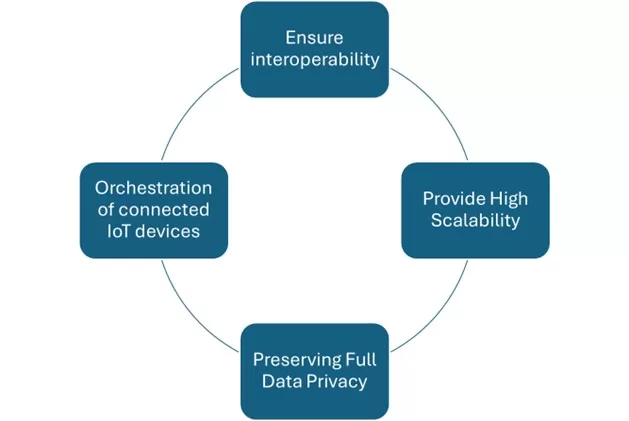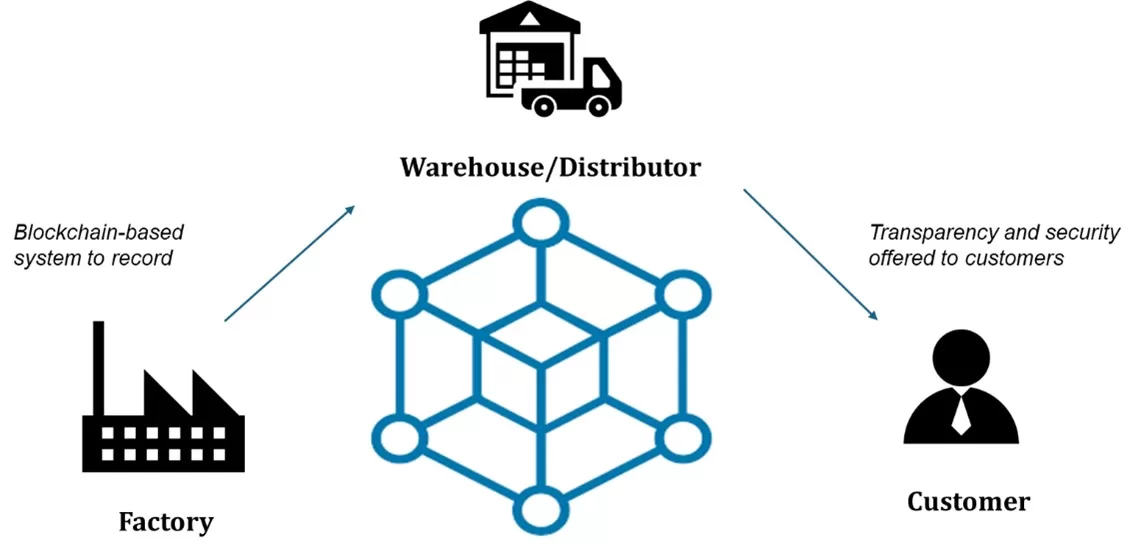Introduction
Industrial Internet of Things (IIoT) represents a core component of Industry 4.0, enabling unprecedented levels of connectivity, monitoring, and automation across various industrial sectors. As industries increasingly integrate IoT devices into their core operational frameworks, the ability to collect, analyze, and leverage data in real time becomes pivotal. However, this integration also introduces significant challenges, particularly regarding data security, efficient data handling, and operational optimization.
Current IIoT ecosystems are often hindered by issues such as data silos, security vulnerabilities, and the inefficiency of traditional centralized systems in handling the vast amounts of data generated by industrial IoT devices. Furthermore, the critical nature of industrial operations requires that these systems not only gather, and process data efficiently but also ensure the utmost integrity and confidentiality of information.
In response to these challenges, two emerging technologies—blockchain and deep reinforcement learning (DRL)—offer compelling solutions. Blockchain technology, with its decentralized nature, provides a robust framework for secure and transparent data transactions across networked devices, ensuring data integrity and reducing the risks of cyber threats. On the other hand, DRL offers sophisticated algorithms capable of learning and making decisions dynamically to optimize data collection processes and resource allocation without human intervention.
Blockchain in IIoT
Blockchain technology has proven effective in managing, controlling, and securing IoT applications. By addressing security issues, blockchain ensures scalability, security, interoperability, and orchestration for IoT devices.

Figure 1:Blockchain in IoT
Enhancing Security and Trust
Blockchain provides a secure environment for data transactions in IIoT ecosystems. Its distributed ledger system records each transaction in a cryptographically secure block, linked to previous blocks. This immutability protects data from tampering and unauthorized access, significantly reducing cyberattack risks. The decentralized nature of blockchain eliminates single points of failure, enhancing network resilience.
Facilitating Secure Data Exchange
Blockchain enables secure and transparent data exchange among IoT devices. Data transactions are recorded and verified by all participating nodes, ensuring transparency and trust. Encryption and consensus algorithms secure peer-to-peer messaging and transmission, while private blockchains allow controlled access and monitoring by administrators.
Scalability
Blockchain’s decentralized computing improves scalability and fault tolerance in IoT applications. The peer-to-peer network can handle millions of transactions from billions of devices without relying on central gateways, eliminating network overheads and the “man-in-the-middle” procedure.
Interoperability
Interoperability allows efficient data exchange between IoT systems while maintaining data integrity. Blockchain platforms offer various consensus algorithms to support different applications. Blockchain bridges facilitate cross-communication between different chains, reducing network traffic and enabling better decentralized apps.
Use Cases and Applications
The integration of blockchain and Deep Reinforcement Learning (DRL) within Industrial Internet of Things (IIoT) systems has shown promising results across various industrial sectors. These case studies and applications illustrate the practical benefits and transformative potential of combining these technologies.

Figure 2: Example of Use Case in Manufacturing
Smart Manufacturing
In smart manufacturing, the integration of blockchain and DRL is revolutionizing production processes. A notable example is a factory setting where blockchain is used to secure data from sensors and machines, ensuring that the data is immutable and traceable. DRL algorithms then utilize this blockchain-verified data to optimize production schedules, predict equipment maintenance needs, and allocate resources efficiently.
For instance, a manufacturing plant may implement a blockchain-based system to record every step in the production process, from raw material sourcing to finished product assembly. DRL algorithms analyze this data to identify patterns and anomalies, allowing for real-time adjustments to production lines. This approach not only enhances operational efficiency but also minimizes downtime by predicting and preventing equipment failures.
Supply Chain Management
Supply chain management greatly benefits from the transparency and security offered by blockchain combined with the optimization capabilities of DRL. Companies are using blockchain to ensure the traceability of products, tracking their journey from origin to final destination. DRL algorithms, in turn, optimize logistics, inventory management, and delivery schedules based on the data recorded on the blockchain.
For example, a global logistics company might deploy a blockchain platform to log every transaction and movement of goods across its supply chain. DRL models analyze this data to optimize routes, reducing fuel consumption and delivery times. This integration also enhances the ability to respond to disruptions, such as delays or demand surges, by dynamically adjusting logistics strategies.
Healthcare and Medical IoT
In healthcare, the combination of blockchain and DRL enhances patient data security and optimizes medical resource allocation. Blockchain ensures that patient records and medical data are stored securely and cannot be tampered with, while DRL algorithms analyze this data to predict health trends and optimize care delivery.
For instance, a hospital might use a blockchain system to store patient data, ensuring that only authorized personnel can access and update records. DRL models analyze this data to predict patient admission rates, optimize staffing levels, and allocate medical resources effectively. This approach improves patient outcomes by ensuring that the right resources are available at the right time.
Integrating Deep Reinforcement Learning
DRL represents a powerful convergence of deep learning and reinforcement learning, offering advanced capabilities for optimizing decision-making processes in complex environments.
The integration of Blockchain and DRL represents a powerful synergy, combining the security and transparency of blockchain with the adaptive optimization capabilities of DRL. This integrated approach addresses several critical challenges in IIoT, such as data integrity, secure communication, and efficient resource management, while paving the way for innovative industrial solutions.
DRL combines the perceptual and cognitive capabilities of deep learning with the goal-oriented learning mechanisms of reinforcement learning. In essence, DRL systems consist of an agent that interacts with an environment, taking actions based on observed states to maximize a cumulative reward. Through continuous interactions, the agent learns optimal policies to achieve desired outcomes, even in uncertain and dynamic conditions.
Despite its promising applications, the implementation of DRL in IIoT is not without challenges. DRL models require substantial computational resources for training and inference, which can be a limitation in resource-constrained industrial environments. The complexity of industrial processes necessitates robust DRL models that can handle diverse scenarios and uncertainties.
Challenges and Future Directions
Addressing these challenges is crucial for the successful implementation and widespread adoption of these technologies in industrial environments. Moreover, exploring future directions can pave the way for advancements that will further enhance the capabilities and applications of blockchain and DRL in IIoT.
Computational Demands and Resource Constraints
One of the primary challenges in integrating blockchain and DRL is the high computational and resource demands of both technologies. Blockchain requires substantial processing power and storage capacity to maintain and verify the distributed ledger, particularly in large-scale IIoT networks. Similarly, DRL algorithms necessitate significant computational resources for training and real-time decision-making. In resource-constrained environments, such as remote industrial sites or battery-powered IoT devices, these demands can be prohibitive.
Research and development should focus on optimizing blockchain and DRL algorithms to reduce computational overhead and improve efficiency. Lightweight blockchain protocols, such as those designed for IoT, can help mitigate resource constraints. Additionally, advancements in hardware acceleration, such as the use of specialized chips for DRL, can enhance performance while minimizing energy consumption.
Interoperability and Integration
Ensuring interoperability between different blockchain platforms and DRL frameworks is essential for seamless integration within existing IIoT infrastructure. The diverse range of protocols, standards, and technologies used in industrial systems can create compatibility issues, hindering the deployment of integrated solutions.
Developing standardized interfaces and protocols for blockchain and DRL can facilitate interoperability and integration. Industry collaboration and the establishment of common standards will be crucial in this regard.
Security and Privacy Concerns
While blockchain enhances data security and transparency, the integration of DRL introduces new security and privacy challenges. DRL models require access to vast amounts of data, including potentially sensitive information. Ensuring the confidentiality and integrity of this data during training and inference is critical.
Implementing privacy-preserving techniques, such as federated learning and homomorphic encryption, can address security and privacy concerns in DRL. These approaches enable decentralized training and secure data processing without exposing sensitive information. Additionally, continuous monitoring and auditing of blockchain and DRL systems can help detect and mitigate security threats.
Energy Efficiency
Energy consumption is a critical consideration in IIoT environments, particularly for battery-operated devices. Both blockchain and DRL can be energy-intensive, potentially offsetting the benefits of their integration. Finding ways to optimize energy usage while maintaining performance is vital for sustainable IIoT deployments.
Developing energy-efficient blockchain protocols and DRL algorithms is a key research area. Techniques such as energy harvesting, adaptive power management, and the use of low-power hardware can enhance the sustainability of IIoT systems. Additionally, integrating renewable energy sources into IIoT infrastructure can reduce the overall environmental impact.
Future Prospects
Despite these challenges, the integration of blockchain and DRL in IIoT holds immense potential for future advancements. As research and development continue, several promising directions can be explored:
- Hybrid Architectures: Combining on-chain and off-chain processing can balance the benefits of blockchain’s security and DRL’s real-time optimization capabilities while addressing scalability and efficiency issues.
- Cross-Industry Applications: Exploring the application of blockchain and DRL across different industries, such as agriculture, transportation, and healthcare, can unlock new use cases and drive innovation.
- Collaborative Ecosystems: Building collaborative ecosystems where multiple stakeholders, including industry, academia, and government, work together can accelerate the development and deployment of integrated solutions.
Conclusion
The integration of blockchain and Deep Reinforcement Learning (DRL) within Industrial Internet of Things (IIoT) ecosystems offers a transformative approach to addressing key challenges in data security, operational efficiency, and resource management. Blockchain’s decentralized and immutable ledger ensures the integrity and security of data transactions, providing a robust foundation for secure communication and interoperability among IoT devices. DRL complements this by offering sophisticated, adaptive optimization capabilities, enabling real-time decision-making and efficient resource allocation.
Together, these technologies enhance various industrial applications, from smart manufacturing and supply chain management to healthcare and energy management.
However, the successful implementation of these technologies is not without challenges. The high computational and resource demands, interoperability issues, and security concerns associated with DRL and blockchain need to be addressed.
Future research should focus on optimizing algorithms for efficiency, developing standardized protocols for interoperability, and implementing privacy-preserving techniques to secure sensitive data.
As these technologies continue to evolve, their combined application will likely lead to smarter, more resilient industrial environments, ultimately driving the next wave of industrial innovation and efficiency.
References
- 3rd Generation Partnership Project; Technical Specification Group Services and System Aspects; Study on authentication enhancements in 5G System; (Release 17); 3GPP TR 33.846 V0.7.0. 2020.
- Alam, T. ,”Blockchain-Enabled Deep Reinforcement Learning Approach for Performance Optimization on the Internet of Things”. Wireless Pers Communhttps://doi.org/10.1007/s11277-022-09780-1
- Liu et al, “Performance optimisation for blockchain-enabled industrial Internet of Things (IIoT) systems: A deep reinforcement learning approach”. IEEE Transactions on Industrial Informatics

